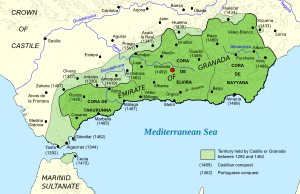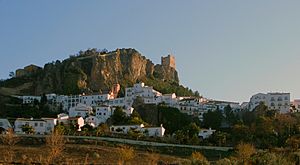Border of Granada facts for kids
The border of Granada (called frontera de Granada in Spanish) was a special area between the Nasrid kingdom of Granada and the Christian kingdoms of Murcia, Jaén, Córdoba, and Seville. These Christian kingdoms were once Muslim lands that became part of the Crown of Castile in the mid-1200s.
The exact line of this border changed a few times. But after King Alfonso XI died in 1350, the border of Granada stayed mostly the same until the Granada War began in the late 1400s. This area was also known as La Banda Morisca, which means "The Moorish Strip."
Contents
Place Names from the Border
Many modern towns still have names that show their connection to this old border. These names often include "de la Frontera" (meaning "of the Frontier" or "of the Border").
- In the Province of Cadiz: Arcos de la Frontera, Castellar de la Frontera, Chiclana de la Frontera, Conil de la Frontera, Jerez de la Frontera, Jimena de la Frontera, and Vejer de la Frontera.
- In the province of Malaga: Cortes de la Frontera.
- In the province of Cordoba: Aguilar de la Frontera.
- In the province of Sevilla: Morón de la Frontera.
Some towns in the Huelva province also have "de la Frontera" in their names. However, these refer to the border with Portugal, not the border of Granada. Examples are Rosal de la Frontera and Palos de la Frontera.
Where the Border Was
The first border was set in 1246 by the Pact of Jaén. This agreement was made between Muhammad I "ibn al-Ahmar," the first king of Granada, and King Fernando III 'El Santo' of Castile. This happened after Castile had conquered many lands in the Guadalquivir valley.
The border changed a bit during the reigns of later kings like Sancho IV, Fernando IV, and Alfonso XI. But after Alfonso XI died in 1350, the border became more stable. It stayed this way until the War of Granada in the late 1400s.
The border line started near the Strait of Gibraltar. It went north through the Sierra de Montecoche until it reached the Guadalete River. Then, it turned east, running along the northern hills of the Serranía de Ronda. From the Guadalteba and Yeguas rivers, it went northwest. It passed through the mountains south of Benameji, Rute, Priego de Cordoba, and Alcala la Real.
It continued along the Guadalbullon River valley up to the Sierra Magina mountains. Then, it went northeast, skirting the hills of Sierra de Cazorla and Sierra de Segura. It entered Murcian territory, where a thick forest acted as a buffer zone (a safe area between two places). The southern part of the Kingdom of Valencia, from Alcoy and Cocentaina to the sea, also formed a border area.
Life on the Border
For over two centuries, this border was very important. It was not just any border; it was the edge between Christianity and Islam in Europe. This meant it was a place of much exchange, both legal and illegal. People traded goods, including items from the East. But there were also military raids to steal things or capture people for the slave trade. Sometimes, captives were held for ransom. Religious groups often got involved in these situations.
Kings gave special rights and benefits to towns along the border. This was to encourage people to live there, even though it was dangerous. Even during peaceful times, there was always a risk of raids from Granada.
Life in border towns was often isolated. People focused on military activities because they lived next to an enemy. Town councils wanted people who could afford horses and weapons. Most of the army was made up of foot soldiers. Some people came to the border to smuggle goods. Others were criminals who wanted to avoid punishment by serving the king.
The settlements were often small, fortified towns built close together. They had few people and were mainly for defense.
The main economic activity was ranching. There weren't enough people for farming, and the land was not safe. So, raising livestock, especially sheep and goats, was important. Animals could be moved and protected inside the walls of fortresses and cities if there was an attack.
One important result of the border was the creation of the military role called Adelantado Mayor de la Frontera (Major Governor of the Border). This role helped keep the spirit of Christian crusades and Islamic Jihad (holy struggle) alive. It also kept alive the idea of chivalry, which was becoming old-fashioned in other parts of Europe. By the 1400s, there was a strong desire to finish the Reconquista (reconquest) and take back the land that was once the Visigothic Kingdom of Toledo.
Border Ballads
The border also led to a unique form of art and culture: the border romances (or ballads). These were poems or songs that told stories about historical events. They often described the capture of important cities like Antequera, Álora, Alhama, which happened before the final capture of Granada.
These ballads also told stories of knights and their adventures or sorrows on the frontier. They likely came from medieval chanson de geste (songs of heroic deeds). Minstrels (traveling musicians and storytellers) helped spread these ballads across Spain from the 1300s onwards. So, the border played a big part in how people in Spain viewed Islam.
The Border After the Reconquista
Even after the Kingdom of Granada was conquered, it kept some of its unique features. For example, some taxes and customs duties were still collected on the old border with Andalusia and Murcia, especially on silk from Granada.
See also
 In Spanish: Frontera de Granada para niños
In Spanish: Frontera de Granada para niños
- Kingdom of Granada
- Reconquista
- Almogavars
- Ballestero de monte
- Granada War
- Andalusia



